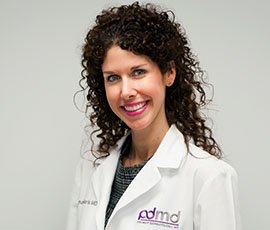Full body checkup? Here's what to expect:
Is it your first full body skin exam at the dermatologist? First of all, congratulations for taking care of your skin's health. Here's what to expect:
1. Dermatologists look EVERYWHERE.
Yes, everywhere. From the top of the head down to in-between toes, including the groin area and buttocks. Skin cancers and abnormal moles can come up where the sun doesn't shine, so it's important to have a thorough exam. There's no need to feel shy or embarrassed. Dermatologists are medical doctors who, in addition to completing four years of medical school, have had an additional four years of internship and residency training. Our medical training and experience make dermatologists the experts in skin conditions.
2. Skin exams should be done once a year.
Just like a yearly checkup at the internist, regular full skin examinations allow for earlier detection and treatment of skin cancer and abnormal moles. People with a history of melanoma or multiple non-melanoma skin cancers may require more frequent exams, based on their dermatologist's recommendations.
3. Dermatologists are not concerned with hairy legs or non-pedicured toes. Or non-matching undergarments.
Your doctor does not care if you haven't shaved all winter long! Dermatologists are busy looking for suspicious spots when we conduct our exams.
4. Early detection saves lives.
Diagnosing and treating skin cancer such as melanoma in its earliest stages greatly improves prognosis. In fact, for very early stage melanoma located at the site where it started, the 5 year survival is 99%. When basal cell carcinomas and squamous cell carcinomas are found early, they can be easily treated in the office.
5. Kids can get full body skin examinations.
Having family members with melanoma, being fair skinned, having light eyes, and a history of sunburns all increase the risk of melanoma and other types of skin cancer. Kids with many moles or with risk factors would benefit from skin exams.
Take care of yourself and your loved ones and schedule a full body skin exam!
Categories
- November 2014 (1)
- December 2014 (3)
- January 2015 (4)
- February 2015 (3)
- March 2015 (1)
- April 2015 (3)
- May 2015 (4)
- June 2015 (2)
- July 2015 (0)
- August 2015 (1)
- September 2015 (2)
- October 2015 (4)
- November 2015 (1)
- December 2015 (1)
- January 2016 (2)
- February 2016 (1)
- March 2016 (3)
- April 2016 (2)
- May 2016 (1)
- June 2016 (1)
- August 2016 (1)
- October 2016 (1)
- January 2017 (1)
- February 2017 (1)
- June 2017 (1)
- August 2017 (1)
- October 2017 (1)
- December 2017 (1)
- April 2018 (1)
- May 2018 (1)
- November 2018 (1)
- May 2019 (1)
- July 2019 (1)
- January 2020 (1)
- March 2020 (2)
- July 2020 (1)
- November 2020 (0)
- January 2021 (1)
- October 2021 (1)
- January 2022 (1)
- June 2022 (1)
- November 2022 (1)
- April 2023 (1)
- September 2023 (1)
- September 2023 (1)
- December 2023 (1)
- February 2024 (1)
- July 2024 (1)
- September 2024 (1)
- March 2025 (1)
Archives
Latest on blog
No hair? Don't despair!
Published March 7th, 2025It happens to millions of women and men. It's so frequent, in fact, that there's a billion...
Learn More
